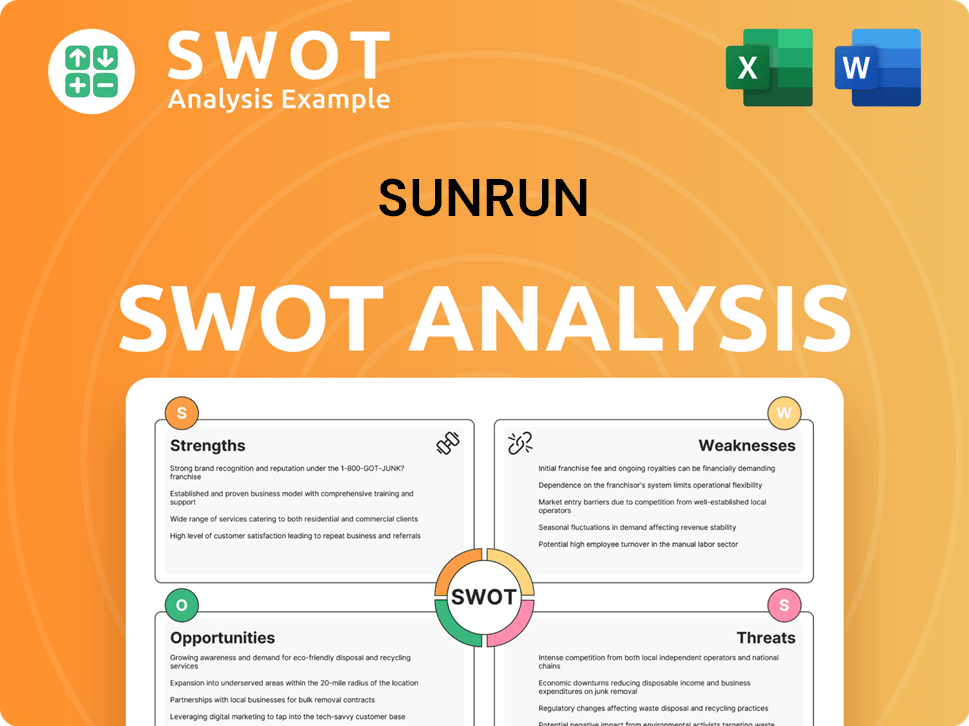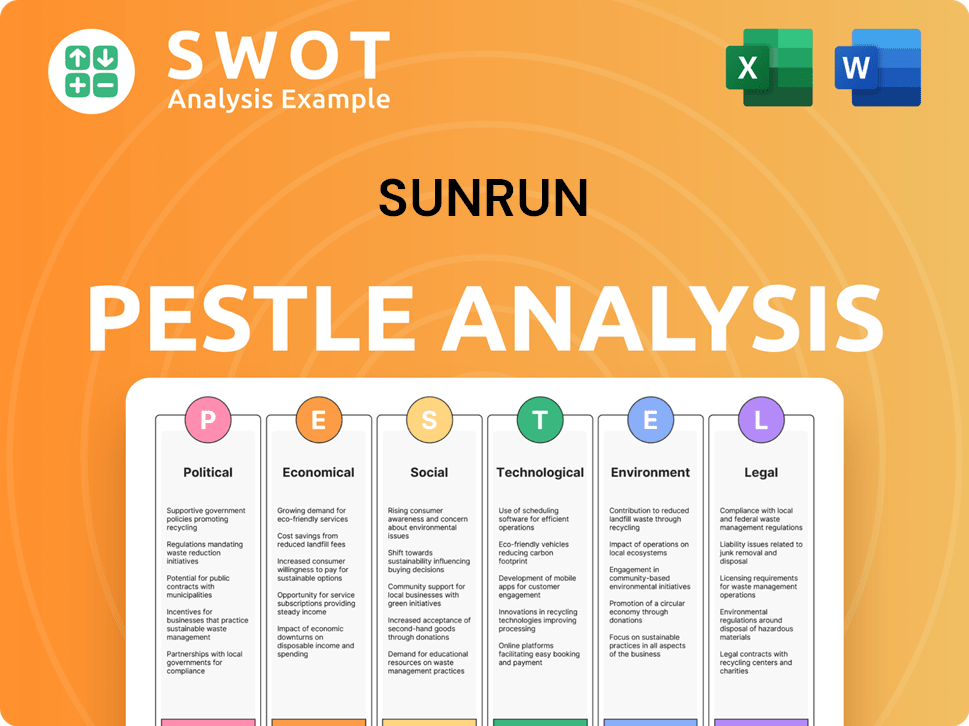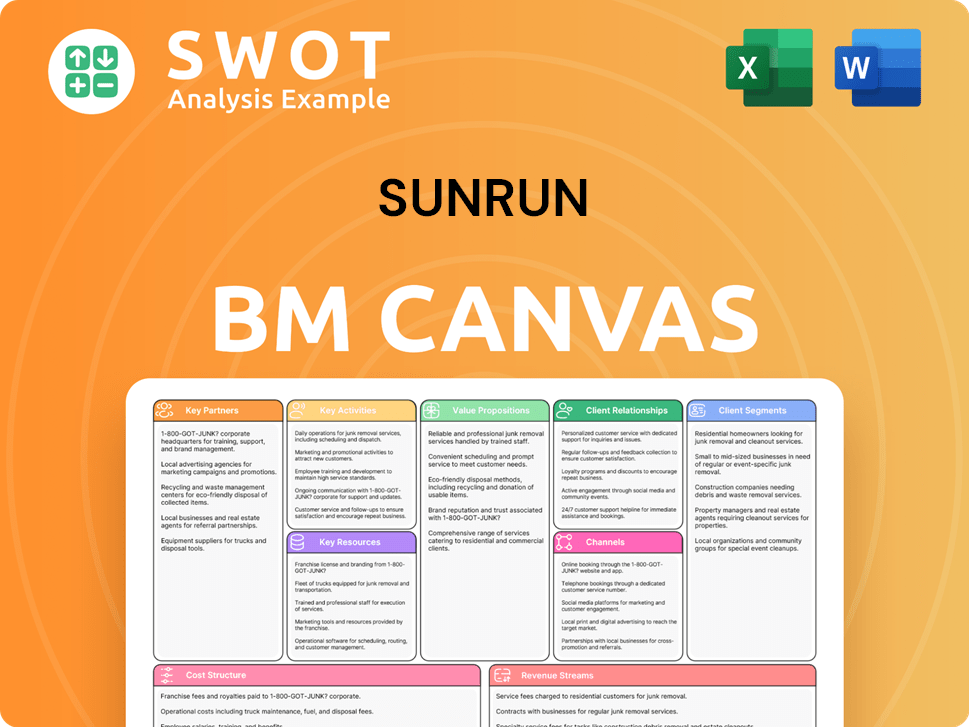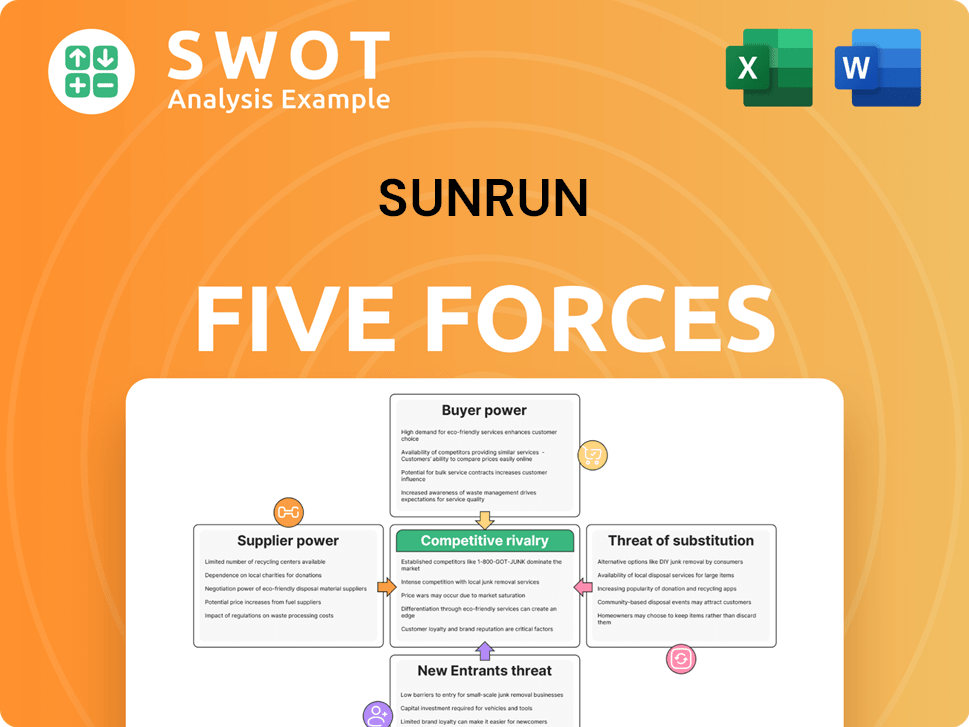Sunrun Bundle
Can Sunrun Maintain Its Solar Dominance?
The residential solar market is a battleground of innovation and competition, with homeowners increasingly seeking sustainable and cost-effective energy solutions. Sunrun, a pioneer in the solar-as-a-service model, has carved a significant niche in this evolving landscape. But how does Sunrun stack up against its rivals in this dynamic Sunrun SWOT Analysis?

This analysis delves into the Sunrun competitive landscape, evaluating its position within the residential solar market and identifying key Sunrun competitors. We'll explore the strategies that have fueled Sunrun's growth, examining its market share analysis and competitive advantages of Sunrun, while also considering the broader solar industry competition and the challenges faced by its rivals. Understanding these dynamics is crucial for anyone looking to navigate or invest in the solar energy sector.
Where Does Sunrun’ Stand in the Current Market?
Sunrun holds a leading market position in the U.S. residential solar industry. Its core operations involve the design, installation, financing, and maintenance of solar panel systems, battery storage solutions, and energy management services. As of Q4 2023, Sunrun had 887,698 customers, demonstrating a strong presence in the market. The company's focus is on providing homeowners with clean energy solutions, helping them reduce electricity costs and increase energy independence.
The company's value proposition centers on offering integrated home energy solutions. This includes not only solar panel installations but also battery storage and energy management services. This approach caters to the growing demand for energy resilience and smart home integration. Sunrun's geographic presence spans across numerous states, allowing it to serve a diverse customer base seeking sustainable living practices. This strategic shift positions Sunrun as a comprehensive energy solutions provider.
Sunrun's financial performance is a key factor in its competitive standing. For the full year 2023, Sunrun reported total revenue of $1.56 billion. This financial scale allows Sunrun to invest in technological advancements, expand its service offerings, and maintain a competitive edge. Sunrun's strong position is particularly evident in states with favorable solar incentives and high electricity rates, where the economic benefits of solar adoption are most pronounced. To learn more about their growth strategy, you can read about the Growth Strategy of Sunrun.
The Sunrun competitive landscape is dynamic, with several key players vying for market share in the residential solar market. Competition includes both national and regional companies that offer similar services. These companies compete on factors such as pricing, financing options, and service quality.
Market dynamics are influenced by government incentives, technological advancements, and consumer preferences. The availability of federal and state incentives significantly impacts the cost-effectiveness of solar installations. Technological advancements in solar panel efficiency and battery storage also play a crucial role in the competitive landscape.
Sunrun's market position is characterized by its large customer base and comprehensive service offerings. The company's focus on integrated home energy solutions, including battery storage, differentiates it from some competitors. Sunrun's brand recognition and established presence in the market are also key strengths.
Competitive advantages of Sunrun include its extensive customer base, financial stability, and integrated service offerings. The company's ability to provide financing options and manage the entire solar installation process enhances its appeal to customers. Sunrun's partnerships and strategic initiatives also contribute to its competitive edge.
Sunrun's main competitors 2024 face challenges such as fluctuating material costs, supply chain disruptions, and regulatory changes. However, the growing demand for clean energy and the increasing adoption of battery storage present significant opportunities for growth. The company must navigate these challenges while capitalizing on market opportunities.
- Solar industry competition is intensifying as more companies enter the market.
- Sunrun's competitive landscape in California and other key states is particularly dynamic.
- Sunrun's market share analysis indicates a strong position, but it is subject to change.
- How does Sunrun compare to Tesla solar is a key question in the market.
Sunrun SWOT Analysis
- Complete SWOT Breakdown
- Fully Customizable
- Editable in Excel & Word
- Professional Formatting
- Investor-Ready Format

Who Are the Main Competitors Challenging Sunrun?
The Revenue Streams & Business Model of Sunrun operates within a dynamic and fiercely contested environment. The Sunrun competitive landscape is shaped by both direct and indirect rivals, all vying for market share in the residential solar and energy services sector. Understanding the key players and their strategies is crucial for evaluating Sunrun's position and future prospects.
The solar industry competition is intensifying, with companies constantly innovating and adapting to stay ahead. This includes changes in pricing models, technological advancements, and customer acquisition strategies. The residential solar market is experiencing significant growth, attracting new entrants and prompting existing players to expand their offerings.
Sunrun faces a multifaceted competitive environment. Its key rivals range from large national installers to regional players and traditional utilities. Each competitor brings unique strengths and strategies to the table, influencing Sunrun's market position and strategic decisions.
Direct competitors primarily focus on residential solar installations and energy services. These companies directly compete with Sunrun for customers.
Tesla Energy is a major competitor, offering solar panels, Solar Roof installations, and Powerwall battery storage. Tesla's brand recognition and direct-to-consumer model are key advantages.
Other national installers like Palmetto Solar and Momentum Solar also compete for customers. These companies often use competitive pricing and localized marketing.
Indirect competitors include traditional utility companies that offer renewable energy programs. They compete for homeowners' energy spending.
New entrants focusing on niche technologies like advanced energy management software also impact the competitive landscape. These companies can disrupt traditional market dynamics.
Mergers and acquisitions, such as the Sunrun-Vivint Solar deal, reshape the competitive landscape. These consolidations reduce the number of large players.
Sunrun's ability to maintain its market leadership hinges on continuous innovation and adaptation. This involves refining product offerings, financing models, and customer service to meet evolving market demands.
- Sunrun market share analysis indicates a strong position, but it faces constant pressure from rivals.
- Sunrun's pricing strategy versus competitors is crucial for attracting and retaining customers.
- Sunrun's growth strategy in the solar market involves expanding into new markets and offering new services.
- Sunrun's competitive landscape in California is particularly important due to the state's high solar adoption rates.
- Sunrun's customer acquisition costs compared to rivals influence profitability and market share.
Sunrun PESTLE Analysis
- Covers All 6 PESTLE Categories
- No Research Needed – Save Hours of Work
- Built by Experts, Trusted by Consultants
- Instant Download, Ready to Use
- 100% Editable, Fully Customizable

What Gives Sunrun a Competitive Edge Over Its Rivals?
Understanding the Sunrun competitive landscape requires a deep dive into its strategic advantages. The company has carved a significant niche in the residential solar market, largely due to its pioneering solar-as-a-service model. This model, which includes power purchase agreements (PPAs) and leases, has been a key differentiator, making solar energy accessible to a wider audience and driving customer acquisition.
Sunrun's success is also underpinned by its extensive operational scale. As one of the largest residential solar installers in the U.S., it benefits from economies of scale in procurement, installation, and operations. This scale allows for competitive pricing and improved margins. Furthermore, the company's investment in proprietary technology and a broad distribution network enhances its ability to serve customers effectively across numerous states.
The company's focus on integrated energy solutions, including battery storage, strengthens its market position. The Brightbox battery, for instance, offers energy resilience, catering to the growing consumer demand for energy independence. The company's brand equity, built over years of market presence, also contributes to customer loyalty and trust. For more insights into the company's target demographic, consider exploring the Target Market of Sunrun.
Sunrun pioneered the solar-as-a-service model, offering PPAs and leases. This approach reduces upfront costs, making solar more accessible. This model has been a cornerstone of its growth and customer acquisition strategy.
As a leading installer, Sunrun benefits from significant economies of scale. This allows for cost efficiencies in procurement, installation, and operations. These efficiencies translate into competitive pricing and improved margins.
Sunrun's extensive distribution network and presence across numerous states provide broad reach. This localized service capability gives it an advantage over smaller players. It ensures effective customer service and support.
The company invests in proprietary technology for system design, monitoring, and energy management. This enhances operational efficiency and customer experience. This includes advancements in battery storage solutions.
Sunrun's competitive edge stems from its solar-as-a-service model, economies of scale, and integrated energy solutions. These factors have helped it establish a strong position in the solar industry competition. However, it faces challenges from evolving regulations and new market entrants.
- Solar-as-a-service model with PPAs and leases.
- Economies of scale in procurement and operations.
- Extensive distribution network and geographic presence.
- Investment in proprietary technology and battery storage.
Sunrun Business Model Canvas
- Complete 9-Block Business Model Canvas
- Effortlessly Communicate Your Business Strategy
- Investor-Ready BMC Format
- 100% Editable and Customizable
- Clear and Structured Layout

What Industry Trends Are Reshaping Sunrun’s Competitive Landscape?
The Sunrun competitive landscape is significantly influenced by the dynamic residential solar market. Technological advancements, evolving consumer preferences, and regulatory changes shape the industry, creating both opportunities and challenges for companies like Sunrun. Understanding these factors is crucial for assessing Sunrun's position and future prospects.
The residential solar market is experiencing rapid growth, driven by a combination of factors, including declining solar panel costs and increasing consumer interest in renewable energy. However, this growth is also accompanied by intense solar industry competition, necessitating continuous adaptation and innovation from players like Sunrun. The Sunrun market analysis reveals a complex interplay of market forces that determine its competitive standing.
The residential solar market is seeing increased adoption of battery storage solutions, driven by grid instability concerns. Smart home integration and energy management systems are also becoming more prevalent. Furthermore, government incentives and net metering policies continue to shape the economic viability of solar installations across different regions. The Brief History of Sunrun provides context on the company's evolution within this landscape.
Sunrun can capitalize on the growing demand for battery storage, particularly with its Brightbox solution. Virtual power plants (VPPs) offer new revenue streams and enhance the value proposition for homeowners. Expansion into new geographic markets with favorable solar policies and high electricity rates presents further growth opportunities. These opportunities require strategic focus and investment.
Changes in net metering policies could reduce the financial benefits of solar in certain regions, potentially decreasing demand. Increased competition from traditional utilities entering the distributed energy space poses a threat. Supply chain disruptions and rising interest rates can also impact installation costs and financing, affecting profitability. These challenges require proactive strategies.
Sunrun is focusing on continuous innovation in its product offerings to remain competitive. Enhancing customer acquisition efficiency is also a key strategy. Advocating for favorable regulatory environments is crucial for long-term success. The company is evolving towards a more comprehensive home energy solutions provider, emphasizing resilience and smart energy management.
The Sunrun competitive landscape is dynamic, with Sunrun competitors constantly adapting. Key factors include changes in government incentives, technological advancements, and consumer preferences. Understanding these elements is crucial for assessing Sunrun's position and future growth potential.
- Declining solar panel prices and increasing efficiency continue to drive adoption.
- Battery storage solutions are becoming more popular, offering resilience and grid support.
- Regulatory changes, like net metering, significantly impact the economics of solar installations.
- Competition from traditional utilities and new entrants is intensifying.
Sunrun Porter's Five Forces Analysis
- Covers All 5 Competitive Forces in Detail
- Structured for Consultants, Students, and Founders
- 100% Editable in Microsoft Word & Excel
- Instant Digital Download – Use Immediately
- Compatible with Mac & PC – Fully Unlocked

Related Blogs
- What are Mission Vision & Core Values of Sunrun Company?
- What is Growth Strategy and Future Prospects of Sunrun Company?
- How Does Sunrun Company Work?
- What is Sales and Marketing Strategy of Sunrun Company?
- What is Brief History of Sunrun Company?
- Who Owns Sunrun Company?
- What is Customer Demographics and Target Market of Sunrun Company?
Disclaimer
All information, articles, and product details provided on this website are for general informational and educational purposes only. We do not claim any ownership over, nor do we intend to infringe upon, any trademarks, copyrights, logos, brand names, or other intellectual property mentioned or depicted on this site. Such intellectual property remains the property of its respective owners, and any references here are made solely for identification or informational purposes, without implying any affiliation, endorsement, or partnership.
We make no representations or warranties, express or implied, regarding the accuracy, completeness, or suitability of any content or products presented. Nothing on this website should be construed as legal, tax, investment, financial, medical, or other professional advice. In addition, no part of this site—including articles or product references—constitutes a solicitation, recommendation, endorsement, advertisement, or offer to buy or sell any securities, franchises, or other financial instruments, particularly in jurisdictions where such activity would be unlawful.
All content is of a general nature and may not address the specific circumstances of any individual or entity. It is not a substitute for professional advice or services. Any actions you take based on the information provided here are strictly at your own risk. You accept full responsibility for any decisions or outcomes arising from your use of this website and agree to release us from any liability in connection with your use of, or reliance upon, the content or products found herein.